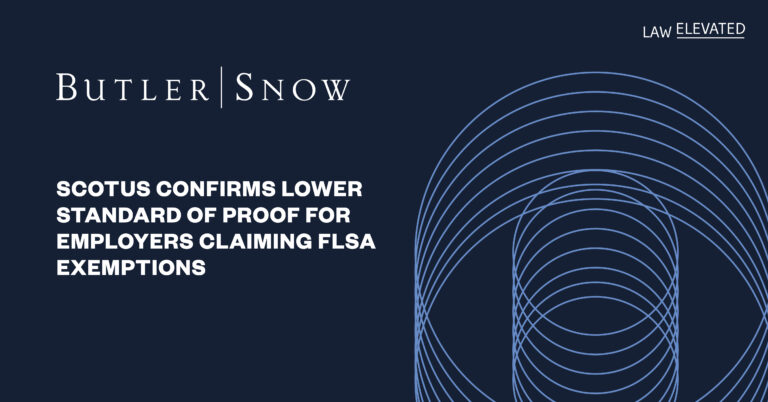Last month the United States Supreme Court (“SCOTUS”) delivered a pro-employer ruling on the standard of proof required under certain provisions of the Fair Labor Standards Act (FLSA). In E.M.D. Sales, Inc. v. Carrera, the Supreme Court established that employers need only prove by a preponderance of the evidence—rather than clear and convincing evidence– that an employee is exempt from the minimum wage and overtime pay requirements of the FLSA.
The employer in the case, EMD, is a distributor of international food products that employs sales representatives who manage inventory at stores that stock EMD products. The company’s sales representatives sued EMD alleging that the company failed to pay them overtime in violation of the FLSA. EMD argued that the employees were subject to an exemption from the overtime-pay requirements of the FLSA, and thus not entitled to overtime.
As a refresher, the Fair Labor Standards Act (FLSA) guarantees a federal minimum wage for covered employees and requires overtime pay for those working more than 40 hours per week. 29 U.S.C. §201 et. Seq; however, certain categories of employees are exempt from the FLSA’s minimum wage and/or overtime pay requirements (e.g., executive, administrative, professional, and outside sales employees). See 29 U.S.C. §213(a)(1). Generally, eligibility for exempt status is based on the nature of the employee’s job duties, as well as the amount and method of compensation for the position.
While FLSA plaintiffs bear the burden to prove the elements of their claims, the default assumption under the law is that an employee is subject to all provisions of the FLSA. If an employer is defending an overtime claim on the grounds that an exemption applies, the employer must assert exempt status as an affirmative defense. Accordingly, the employer has the burden of proof on the exemption. The question then, is, what level of proof is required? In 1938, when Congress passed the FLSA, the default standard of proof in civil litigation was “preponderance of the evidence”—meaning that a party must convince the judge or jury that there is a greater than 50% chance that their claim is true. However, over the years, typically based on public policy grounds, some courts have applied the more stringent “clear and convincing evidence” standard to FLSA exempt classification defenses.
For example, in Carrera, the United States District Court for the District of Maryland held that the employer had to establish the exemption by clear and convincing evidence and that it had failed to do so with respect to its sales representatives. The company appealed, arguing that the District Court erred when it applied the heightened clear and convincing standard because it should have applied the less stringent preponderance of the evidence standard. The Fourth Circuit Court of Appeals disagreed with the company and affirmed the District Court opinion. This decision by the Fourth Circuit created a circuit split on the issue.
The employer in Carrera appealed to SCOTUS, which accepted the case in order to resolve the issue. In considering the issue, SCOTUS noted that the statutory language of the FLSA is silent as to a specific standard of proof and that, therefore, the default “preponderance of the evidence” standard should apply because “[s]tatutory silence is generally ‘inconsistent with the view that Congress intended to require a special, heightened standard of proof.’” Carrera, 604 U.S. __ (quoting Grogan v. Garner, 498 U.S. 279, 286-87 (1991)).
Bottom Line
The Carrera decision is a win for employers seeking to defend against FLSA claims as it clarifies that employers need only show that an employee’s position is more likely than not exempt under the FLSA. Nevertheless, employers should continue to conduct a thorough analysis prior to classifying an employee as exempt, periodically review employee classifications, and maintain updated and detailed records of employees’ job duties and pay. Regardless of the standard of proof, the burden is still on employers to prove that an employee is properly classified as exempt under the FLSA.
If you have any questions about your company’s employment practices, as always, it is best to talk to an experienced employment attorney.
